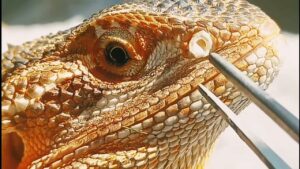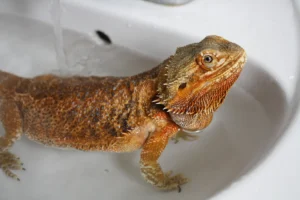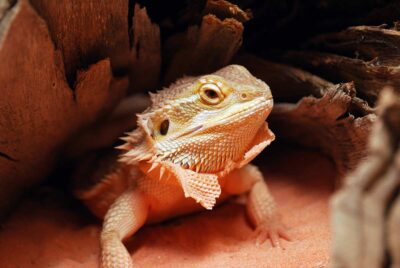Shedding is a natural and essential process for bearded dragons, allowing them to grow and maintain healthy skin. However, eye shedding, where the protective layer around the eyes comes off, can be a bit more complex.
Unlike other parts of their body, the eyes require special attention during this process. Understanding how and why bearded dragons shed around their eyes, and recognizing the signs of potential issues, is crucial for ensuring their comfort and health.
In this guide, we’ll explore what you need to know about bearded dragon eye shedding, including common causes, symptoms, and how to manage this important aspect of their care.
Understanding eye shedding in bearded dragons

Eye shedding in bearded dragons, also known as ocular or eye caps shedding, is a normal part of their shedding process. Bearded dragons periodically shed their skin to grow and renew their outer layer. Here’s a quick guide to understanding and managing eye shedding:
What is Eye Shedding?
- Natural Process: Like other parts of their body, bearded dragons shed the skin around their eyes. This can happen in patches or in one go.
- Timing: Eye shedding usually coincides with a full-body shed. However, if you notice the eyes shedding independently, it could be part of their natural cycle or due to an underlying issue.
Care Tips:
- Maintain Humidity: Ensure the enclosure has proper humidity levels. A humidity range of 30-40% is ideal for bearded dragons.
- Provide a Soaking Spot: Offering a shallow dish of water or misting the enclosure can help with the shedding process.
- Avoid Disturbance: Let the shedding process happen naturally. Avoid trying to peel off the skin as this can cause injury.
- Monitor Health: Keep an eye on your bearded dragon’s overall health. If the shedding process is incomplete or seems problematic, consult a vet.
If you notice anything unusual or if the eye shedding process seems to be causing distress, it’s always a good idea to consult with a reptile vet to ensure everything is on track.
Normal vs. Abnormal Shedding
Understanding the difference between normal and abnormal shedding in bearded dragons is crucial for their well-being. Here’s a breakdown to help you distinguish between the two:
Normal Shedding:
- Clear, Complete Skin Loss:
- The shedding should occur in one or multiple pieces and not leave behind remnants.
- Skin might come off in patches, including around the eyes, but the process should be gradual.
- Cloudy Eyes Before Shedding:
- It’s common for the eyes to appear cloudy or blue just before shedding.
- This cloudiness is temporary and clears up once the old skin is fully shed.
- Behavioral Changes:
- Bearded dragons may become slightly more reclusive or less active during shedding.
- They may also rub their body against objects to help remove the old skin.
- Healthy Skin Appearance Post-Shed:
- Once the shed is complete, the new skin should be bright, smooth, and well-hydrated.
Abnormal Shedding:
- Incomplete Shedding:
- Pieces of old skin, especially around the eyes or toes, remain stuck. This can be caused by low humidity or dehydration.
- Sometimes called “retained shed,” which can lead to complications if not addressed.
- Persistent Cloudiness or Discomfort:
- If the eyes remain cloudy or show signs of redness, swelling, or discharge beyond the usual shedding period, it may indicate an issue.
- Signs of discomfort or irritation around the eyes could be due to infection or injury.
- Behavioral Changes:
- If the bearded dragon seems unusually lethargic, shows signs of stress, or exhibits difficulty moving, it could be related to problematic shedding.
- Skin Issues:
- If the new skin looks abnormal, such as showing signs of infection, irritation, or discoloration, it could indicate a problem.
- Persistent skin problems or lesions that do not heal properly can be a cause for concern.
What to Do:
- For Normal Shedding:
- Ensure that the enclosure has appropriate humidity and temperature.
- Provide a water dish for soaking and mist the enclosure if needed.
- For Abnormal Shedding:
- Increase humidity levels and offer a soaking dish to help with shedding.
- Gently remove any retained skin if it’s safe to do so, but avoid pulling or tearing.
- Consult a vet if there are signs of infection, persistent discomfort, or if shedding problems are recurrent.
Monitoring your bearded dragon’s shedding process and addressing any abnormalities promptly can help ensure they stay healthy and comfortable.
Causes of Eye Shedding

Here’s a comprehensive list of potential causes and factors related to eye shedding in bearded dragons. While not all may apply to every situation, this should cover a broad spectrum of possibilities:
- Normal Growth Cycle: Regular, periodic shedding as part of the natural growth process.
- Environmental Humidity: Low humidity can lead to incomplete shedding or complications.
- Dehydration: Insufficient water intake can affect the shedding process.
- Temperature Fluctuations: Incorrect temperature ranges in the enclosure can impact shedding.
- Improper Lighting: Lack of appropriate UVB lighting may affect overall health and shedding.
- Inadequate Diet: Poor nutrition or deficiencies can impact skin health and shedding.
- Infections: Bacterial or fungal infections can cause abnormal shedding or eye issues.
- Parasitic Infestations: Internal or external parasites might affect skin and eye health.
- Eye Injuries: Physical damage to the eyes can interfere with normal shedding.
- Stress: High-stress levels from changes in environment, handling, or other factors can affect shedding.
- Skin Conditions: Dermatitis or other skin conditions can impact the shedding process.
- Overexposure to Chemicals: Exposure to cleaning agents or other chemicals might irritate the eyes and skin.
- Nutritional Imbalances: Imbalances in calcium, vitamin A, or other nutrients can affect skin and eye health.
- Mites: Eyelid mites or other external parasites can cause eye problems and affect shedding.
- Genetic Factors: Some bearded dragons may have genetic predispositions that affect their shedding.
- Allergies: Allergic reactions to bedding, food, or environmental factors might affect shedding.
- Inadequate Habitat: Poor enclosure setup or lack of proper hiding spots can contribute to shedding issues.
- Age: Young or older bearded dragons might experience different shedding patterns or issues.
- Inadequate Substrate: Substrates that cause irritation or are ingested can affect skin and eye health.
- Excessive Handling: Over-handling or rough handling might stress the dragon and impact shedding.
- Molting Disorders: Rare disorders affecting the molting process can cause shedding issues.
- Illness: Systemic health problems can influence the shedding process and eye health.
- Retained Eye Caps: If the eye caps do not shed properly, it can lead to ongoing issues.
- Respiratory Infections: Infections affecting breathing can also impact eye and skin health.
- Unclean Enclosure: Dirty or unsanitary conditions can lead to infections and skin problems.
- Improper Calcium to Phosphorus Ratio: Imbalances in calcium and phosphorus can affect skin and eye health.
- Overheating: Excessive heat can cause dehydration and impact the shedding process.
- Underheating: Inadequate heat can affect digestion and overall health, leading to shedding issues.
- Behavioral Changes: Changes in behavior, such as hiding or decreased appetite, might indicate underlying problems affecting shedding.
- Improper Ventilation: Poor air circulation in the enclosure can lead to humidity problems and affect shedding.
Regular monitoring and proper care can help prevent many of these issues and ensure a smooth shedding process for your bearded dragon. If any problems persist, consulting a reptile vet is always a good step.
Signs of Eye Shedding
Recognizing the signs of eye shedding in bearded dragons can help you determine if their shedding process is normal or if they might need extra care. Here are some common signs:
Signs of Eye Shedding:
- Cloudy or Bluish Eyes: The eyes may appear cloudy or bluish before shedding, indicating the buildup of fluid beneath the old skin layer.
- Partial Skin Around Eyes: You might see patches of old skin around the eyes that have not yet been shed.
- Eyes Seem “Sticky”: The eye area may appear sticky or have a residue, which can be a sign that the eye caps are coming off.
- Difficulty Opening Eyes: If your bearded dragon has trouble fully opening its eyes, it might be due to retained eye caps.
- Behavioral Changes: Increased rubbing of the eyes or face against objects in the enclosure can indicate discomfort or the process of removing old skin.
- Discoloration: The eyes might look different in color compared to their normal appearance due to the shedding process.
- Redness or Irritation: Redness or signs of irritation around the eyes can accompany the shedding process if there is difficulty or infection.
- Swelling: Mild swelling around the eyes might be observed as the old skin begins to loosen.
- Excessive Blinking or Squinting: Your bearded dragon may blink more often or squint as it tries to adjust to the shedding of eye caps.
- Dry or Flaky Skin Around Eyes: If the shedding process is incomplete, you might see dry or flaky patches around the eyes.
- Increased Rubbing Behavior: The dragon may rub its face or eyes against surfaces more frequently to help remove the old skin.
- Eye Discharge: There might be a slight discharge if the eye area is irritated or if there is an infection.
- Behavioral Stress: The bearded dragon may appear more stressed or less active during the shedding process.
- Incomplete Eye Cap Removal: Pieces of old skin might remain stuck to the eyes, causing discomfort or affecting vision.
- Difficulty Seeing: The dragon might show signs of difficulty seeing or navigating if the eye caps are not fully shed.
When to Seek Veterinary Help:
- Persistent Cloudiness or Discomfort: If the eyes remain cloudy or show signs of discomfort beyond the usual shedding period.
- Signs of Infection: Redness, swelling, or discharge that persists or worsens.
- Inability to Shed Properly: If pieces of old skin remain stuck or the shedding process seems incomplete.
Regular observation and proper care can help ensure that the shedding process goes smoothly. If you notice any signs of abnormal shedding or if your bearded dragon seems distressed, consulting a vet is advisable.
Managing and Supporting Eye Shedding

When to Seek Veterinary Help
Knowing when to seek veterinary help for your bearded dragon is crucial for their health and well-being. Here are some signs and situations where it’s advisable to consult a reptile vet:
1. Persistent Cloudiness or Discomfort:
- Cloudy Eyes: If the eyes remain cloudy or do not clear up after shedding, it might indicate an underlying issue.
- Discomfort: Signs of discomfort or distress around the eyes that do not improve.
2. Retained Eye Caps:
- Incomplete Shedding: If pieces of old skin or eye caps remain stuck and do not come off naturally, it can cause problems.
- Difficulty Removing: If you’ve attempted to help but the skin remains, professional assistance may be needed.
3. Redness or Swelling:
- Eye Irritation: Persistent redness, swelling, or inflammation around the eyes that doesn’t resolve on its own.
- Eye Injury: Any visible injury or trauma to the eyes that requires treatment.
4. Discharge or Abnormal Secretions:
- Eye Discharge: If there’s noticeable discharge or pus around the eyes, it could indicate an infection.
- Abnormal Secretions: Any unusual fluid or secretion from the eyes.
5. Behavioral Changes:
- Lethargy: Significant changes in activity levels, such as lethargy or lack of appetite, especially if accompanied by shedding issues.
- Difficulty Navigating: Trouble seeing or navigating the environment, which could be linked to eye problems.
6. Persistent Skin Issues:
- Infected Skin: Signs of infection or inflammation on the skin or eyes that persist despite environmental adjustments.
- Abnormal Skin Growths: Unusual growths or lesions on the skin that don’t heal.
7. Problems with Eating or Drinking:
- Loss of Appetite: A significant decrease in eating or drinking, especially if related to shedding difficulties.
- Difficulty Eating: Trouble eating or drinking that could be connected to eye or skin problems.
8. Repeated Shedding Issues:
- Frequent Problems: Repeated or recurring problems with shedding, indicating a possible underlying health issue.
9. Unresponsive to Environmental Adjustments:
- No Improvement: If adjustments to humidity, temperature, and diet do not resolve the shedding issues or other symptoms.
10. Unexplained Symptoms:
- Unusual Symptoms: Any unusual or unexplained symptoms that don’t fit typical shedding behavior or health issues.
Consulting a reptile vet in these situations can help address any underlying health problems and ensure your bearded dragon receives appropriate care and treatment.

